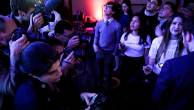Summary of Findings

In a week that saw passage of health care legislation by the Senate Finance Committee, news about health care reform remained front-and-center on the public’s news agenda, topping both public interest and news coverage.
There also has been a sharp increase in the proportion of Americans saying they expect a health care reform bill to pass over the next year – 57% say that currently, up from 45% last week, prior to the Senate Finance Committee’s action.
The latest weekly News Interest Index survey, conducted October 16-19 among 1,004 adults by the Pew Research Center for the People & the Press, finds that public interest in the war in Afghanistan continues to be fairly modest. Only about one-in-ten (9%) cite the war as their top story for the week, which is less than the percentage (14%) that mentioned the story of a boy thought to be aboard a runaway balloon who was later found safe, and the proportion citing swine flu news (20%). The health care debate was the top story – at 32% – as has been the case in most recent weeks.

The public expresses a range of feelings about the news about the war in Afghanistan: a majority (56%) often feels that “it seems like the same news about the war in Afghanistan all the time, nothing ever really changes”; 42% say they do not often feel this way.
Nearly as many (53%) say they do not always have enough background information to follow the news about Afghanistan. By contrast, far fewer Americans (26%) say the news about the war is so depressing they would prefer not to follow it. Only 20% say they feel guilty about not following news from the war in Afghanistan more closely.

Most Americans are unable to correctly estimate the number U.S. military personnel that have been killed in the war in Afghanistan. Just 25% correctly estimate 900 as the fatality count for the war in Afghanistan. Most people (52%) overestimate rather than underestimate the number of U.S. fatalities: 25% say around 1,500 have been killed, while 27% estimate the military death toll at around 2,500. By contrast, a plurality (42%) correctly estimates U.S. troop deaths in Iraq at about 4,300.
Notably, paying very close attention to either conflict, does not significantly improve the chances of knowing the fatality count for a given war. Those following the Afghanistan war very closely or the Iraq war very closely are no more likely than the public at large to correctly estimate the fatality level of each respective war.
Views of Afghanistan News

Those following the U.S. military effort in Afghanistan very closely express different views on war coverage than those following Afghanistan news less closely – especially those following Afghanistan news the least closely.
About four-in-ten (42%) of those following news about the U.S. military effort in Afghanistan very closely say it is the same news all the time with nothing ever really changing; most (56%) do not feel this way. By contrast, 68% of those who follow news about the war not too or not at all closely see it as unchanging.
Similarly, highly attentive Afghanistan news followers do not feel they lack the background information to follow war news (40% say they lack background information, 58% say they do not). The balance of opinion among the less-attentive is the reverse: majorities say they do not always have enough background information to follow the news about the war in Afghanistan.
In addition, 38% of those who do not follow Afghanistan closely say the news can be so depressing they would rather not hear about it; 27% say they feel guilty about not following the news from Afghanistan more closely. Far fewer of those who pay closer attention to news about Afghanistan express these views.
More Trust Military than Press on Afghanistan

Most Americans express either a great deal or a fair amount of confidence in the U.S. military to give the public an accurate picture of how the war in Afghanistan is going. Nearly three-quarters of Republicans (73%) have at least a fair amount of confidence in the military to give an accurate picture of how things are going, compared with 63% of independents and 54% of Democrats.
There is less confidence in the press to provide an accurate account of the war. Overall, 40% of the public expresses at least a fair amount of confidence in the press, compared with 59% who have not too much confidence or none at all. Just a third (33%) of Republicans and 37% of independents say they have a great deal or fair amount of confidence in the press to give an accurate assessment of the war in Afghanistan. By contrast, Democrats express about the same level of confidence in the press (52% great deal/fair amount) as they do in the military (54%).
More Think Health Care Bill Will Pass

By a 57%-38% margin, most Americans say they think a health care reform bill will pass over the next year. Democrats (71%) are the most likely to say they expect a bill to pass, and they are joined in this view by a somewhat smaller majority (56%) of independents. Republicans express mixed views: 47% say they think a bill will pass over the next year, 50% think it will not.
Opinion on this question has changed dramatically from just a week ago. The previous weekly News Interest Index – conducted October 9-12 – found about as many saying they expected a bill to pass (45%) as saying they did not think a bill would pass (46%). In the current survey, the percentage expecting passage of a health care reform bill is up 12 points; the change has been particularly pronounced among Republicans (up 19 points) and Democrats (15 points), while there has been a smaller, nine-point increase in the proportion of independents saying they think a health care reform bill will pass over the next year.
Right Amount of Coverage for Health Care, Iraq, Afghanistan

Pluralities of Americans say news organizations have given the right amount of coverage to the debate over health care reform and the wars in Iraq and Afghanistan. For all three stories, very few say there has been too much coverage.
Just 16% say that news organizations have given too much coverage to the debate over health care reform. About twice as many (36%) say there has been too little coverage, while a 46%-plurality thinks there has been the right amount of coverage of the health care reform debate.
There is little difference between how the public views coverage of the war in Iraq and the war in Afghanistan. For both wars, only 11% say news organizations have devoted too much coverage to the conflicts. Pluralities say that there has been the right amount of coverage for Iraq and Afghanistan (49% and 46%, respectively). And while a minority viewpoint, 36% and 39% say there has been too little coverage of the war in Iraq and the war in Afghanistan.
Afghanistan Interest

In the current survey, 25% of the public say they followed news about the U.S. military effort in Afghanistan very closely, while 9% named news about Afghanistan as their most closely followed story of the week.
Interest in Afghanstan has been largely stable – though modest – through the late-summer and into the fall. New about the U.S. military effort in Afghanistan has consistently been eclipsed by top domestic stories including news about health care reform, swine flu and the economy. The percentage naming Afghanistan as their top story in a given week has lagged behind domestic stories, tracking more closely with news about the war in Iraq.
In addition, very close interest in the war in Afghanistan has not approached 40% this year, a level commonly reached by other leading stories. At the outset of the U.S. military effort in Afghanistan in 2001, very close public interest frequently registered in the 40s or higher.
The Week’s Other News
The public continued to track stories about swine flu and its vaccine last week, with news about the flu trailing only health care reform in terms of public interest. About a third (32%) followed news about swine flu very closely and 20% name it their top story of the week. Women (39% very closely) were more likely to follow this story than men (25% very closely).
About two-in-ten (21%) followed news about a boy thought to be on a runaway balloon very closely. Some 14% say the balloon drama was their top story of the week.

Only modest interest was paid to news about recent gains in the stock market, as the Dow Jones Industrial Average closed above 10,000 points for the first time in more than a year. Some 15% followed stock market news very closely and 6% named it their top story. Interest in the stock market eclipsing 10,000 points was much lower than it was in mid-October of 2008, when the Dow fell below 10,000 points in the midst of a steep decline. A News Interest Index survey conducted October 10-13, 2008 found 59% paying very close attention to “recent major drops in the U.S. stock market.”
These findings are based on the most recent installment of the weekly News Interest Index, an ongoing project of the Pew Research Center for the People & the Press. The index, building on the Center’s longstanding research into public attentiveness to major news stories, examines news interest as it relates to the news media’s coverage. The weekly survey is conducted in conjunction with The Project for Excellence in Journalism’s News Coverage Index, which monitors the news reported by major newspaper, television, radio and online news outlets on an ongoing basis. In the most recent week, data relating to news coverage were collected from October 12-18, 2009 and survey data measuring public interest in the top news stories of the week were collected October 16-19, 2009 from a nationally representative sample of 1,004 adults.
About the News Interest Index
The News Interest Index is a weekly survey conducted by the Pew Research Center for the People & the Press aimed at gauging the public’s interest in and reaction to major news events.
This project has been undertaken in conjunction with the Project for Excellence in Journalism’s News Coverage Index, an ongoing content analysis of the news. The News Coverage Index catalogues the news from top news organizations across five major sectors of the media: newspapers, network television, cable television, radio and the internet. Each week (from Monday through Sunday) PEJ compiles this data to identify the top stories for the week. The News Interest Index survey collects data from Friday through Monday to gauge public interest in the most covered stories of the week.
Results for the weekly surveys are based on landline telephone interviews among a nationwide sample of approximately 1,000 adults, 18 years of age or older, conducted under the direction of ORC (Opinion Research Corporation). For results based on the total sample, one can say with 95% confidence that the error attributable to sampling is plus or minus 3.5 percentage points.
In addition to sampling error, one should bear in mind that question wording and practical difficulties in conducting surveys can introduce error or bias into the findings of opinion polls, and that results based on subgroups will have larger margins of error.
For more information about the Project for Excellence in Journalism’s News Coverage Index, go to www.pewresearch.org/pewresearch-org/journalism.




